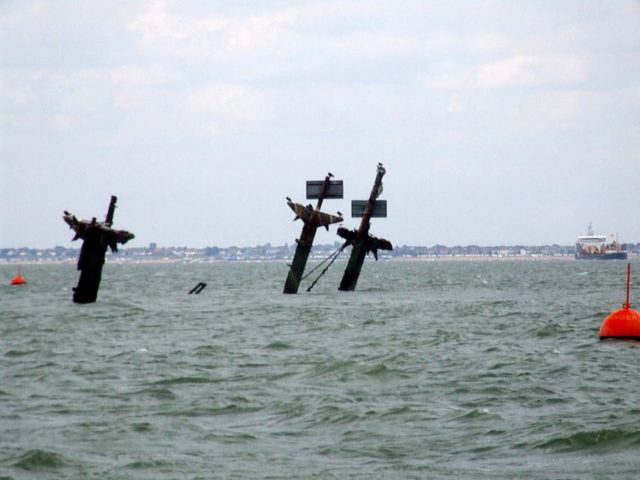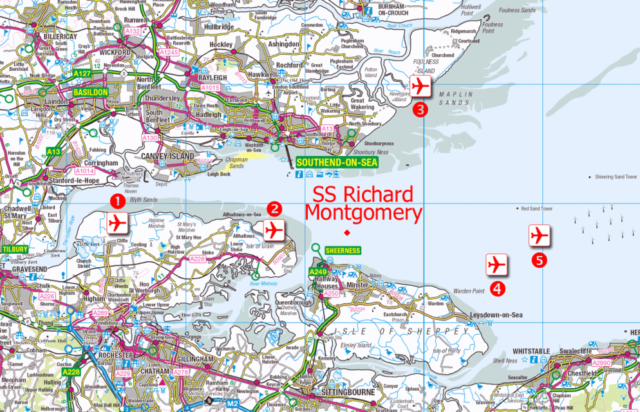WWII Shipwreck near London with 1,400 tons of TNT on Board (Including 286 Blockbuster Bombs) which “could be detonated by a collision”.
The Richard Montgomery was built by the St Johns River Shipbuilding Company in its second year of operation; she was number 7 of 82 similar ships built by this boatyard.

The ship was launched on June 15th , 1943, and had the official number ‘243756’. She was named after an Irish soldier who fought in the American War of Independence and was killed, General Richard Montgomery.
In 1944, in August, she left Hog Island, Philadelphia, and she was fully loaded with munitions equaling 6,127 tons.
She sailed to the Thames Estuary and anchored whilst waiting for a convoy to be formed which would travel with her to Cherbourg, France. This area had fallen under the control of the Allies during the Battle of Normandy.
When she arrived just off Southend she automatically fell under the Thames Naval Control’s authority, and the harbor master commanded the ship to a berth that was just off the Northern edge of Sheerness Sands, an area known as the Great Nore Anchorage.
On August 20th, she dragged anchor and ended up running aground, approximately 250 meters away from the Medway Approach Channel, on a sandbank.
A company from Rochester was given the task of removing the cargo from the ship. This work started on August 23rd, and they planned to use the cargo handling equipment that was already onboard the ship. The following day, the hull had split open and flooded several of the cargo holds.
They continued on with the salvage operation until September 25th, at which point the ship was abandoned with its cargo still onboard. The ship split into two (down the midsection) after they had departed.
An inquiry was launched, and they discovered that several ships which were moored nearby had spotted that the Richard Montgomery was drifting closer and closer to the sandbank. They had tried to alert her Captain, but to no avail, as her Captain had been sleeping.
The Chief Officer could offer no explanation as to why he did not wake the Captain. The inquiry found that the harbor master was at fault for placing her in that spot to anchor and her Captain resumed full duty within one week.
The wreck was surveyed in 2008, and it was found to be at a depth of 49 feet (15 meters) and leaning towards her starboard side. The three masts stand above water level, even at high tide.
Because she holds such a large amount of unexploded munitions, she is closely monitored by the Maritime and Coastguard Agency and is very clearly marked out on all relevant Admiralty Charts. She became the very first shipwreck to be classed as dangerous, in 1973, under Section 2 of the Protection of Wrecks Act. An exclusion zone has been set around her; this is closely monitored both visually and by radar.
An exclusion zone has been set around her; this is closely monitored both visually and by radar.
A survey was taken in 2000 by the United Kingdom Maritime and Coastguard Agency to see what munitions she still held, and they found it was roughly equal to 1400 tons of TNT. These are the items held within the ship:
- 286 × 2,000 lb (910 kg) high explosive bombs “Blockbuster”
- 4,439 × 1,000 lb (450 kg) bombs of various types
- 1,925 × 500 lb (230 kg) bombs
- 2,815 bomb clusters & fragmentation bombs
- Various explosive booster charges
- Various smoke bombs, including white phosphorus bombs
- Various pyrotechnic signals
New Scientist magazine investigated in 2004 and found that this cargo could be detonated by an attack, collision or even shifting movement of the cargo from the tide. The fact that the munitions will be in such bad condition means they could easily detonate at the slightest stimulus.
The Maritime and Coastguard Agency maintain that the risk of a major explosion is very low. An official risk assessment was undertaken in 1999, but the results have never been published though one known conclusion was that ‘doing nothing was not an option for much longer’.
A big reason that they have not removed the explosives is due to an operation that was carried out on a Polish ship Kielce to neutralize the risk of its explosive cargo. During the operation, she exploded with a force that equaled a 4.5 Richter scale magnitude, created a crater that was 20 feet deep in the seabed, and panicked the local people.
A BBC News Report from 1970 claims that, if the Richard Montgomery exploded, the results would be a 300-meter column of water and debris would reach 3,000 meters high and generate a 5-meter tall wave. Nearly all windows in the town of Sheerness would break, and buildings would suffer damage.

In the original assessment there was concern that copper azide may be produced and then react to cause an explosion.
The Maritime and Coastguard Agency said, ‘as the fuses will probably all have been flooded for many years and the sensitive compounds referred to are all soluble in water this is no longer considered to be a significant hazard’.
The site of this wreckage is constantly monitored and regularly surveyed to keep an eye on the structure and stability of the wreck. In 2003 a diver survey was carried out, in 2005, a sonar survey was undertaken, and there had been no movement in the wreck that is significant.
Surveys taken in 2008/2009, however, show that the ship is slowly deteriorating and new fissures are appearing in the bow.
The report says: “Whilst significant structural collapse does not appear to be imminent, surveys suggest that this prospect is getting closer.”
Read another shipwreck story from us:200-year-old shipwreck discovered in the Great Lakes
There have been talks of adding an airport into the Thames Estuary area, and if this were to happen then, the wreck would have to be dealt with.
